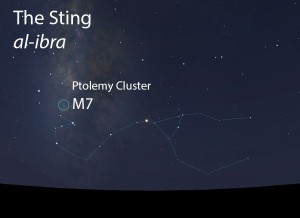Star Names
The Sting (al-ibra)
The Sting of the Scorpion (ibrat al-‘aqrab)
The Sting is part of the Arabian constellation of the Scorpion (al-‘aqrab). The Arabian Scorpion followed the image of the scorpion defined by the Sumerians more than 3000 years ago. The Sting is located near the Raised Tail (ash-shawla) and is marked by a bright cluster of stars.

The Sting (al-ibra) of the Scorpion (al-‘aqrab) as it appears in the west about 45 minutes before sunrise in mid-May. Sky simulations made with Stellarium.
Appearance
A bright star cluster that comes right after the close pair of white stars that mark the Raised Tail.
Modern Identification
M7 (Ptolemy Cluster), star cluster, magnitude 3.3
Timing
Ibn Qutayba (d. 879 CE) reported that the Raised Tail was said to rise on the morning of December 10 and set on the morning of June 10. On account of the precession of the equinoxes, today we can expect to observe the Sting setting in mid-June and rising early January, as seen from the latitude of Tucson. (See How to Observe on the About page for more on this topic.)
Rain Stars
The Sting of the Scorpion does not figure in the calendar of the rains stars.
Lunar Stations
The Sting is not one of the lunar stations, but in early listings of the lunar stations, the Raised Tail is the 21st station of the year.
Related Stars and Celestial Complexes
The Sting is part of the Scorpion (al-‘aqrab, العقرب) folkloric celestial complex, which extends from the Two Claws (az-zubanayan, الزبانيان) to the Raised Tail (ash-shawla, الشولة).
Related Blog Posts
Searing Heat from the Indelible Scorpion

